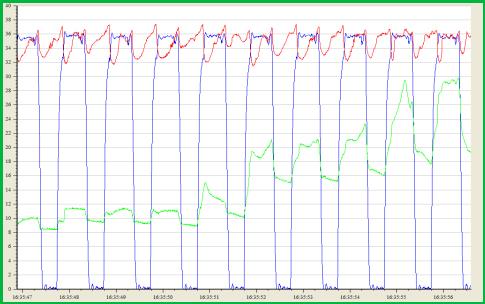When should the cluster be detached for cows?
Published: April 26, 2018
By: M.D. Rasmussen 1, A. Dzidic 2, V. Tancin 3, R. Ginsberg 4, R.M. Bruckmaier 5, D.J. Reinemann 6.
/ 1 Dept. of Engineering, Aarhus University, Denmark; 2 Dept. of Animal Science, University of Zagreb, Croatia; 3 Research Institute of Animal Production Nitra, Slovakia; 4 Milking Management, Parlor Specification and Operation, Israel; 5 Veterinary Physiology, Vetsuisse Faculty University of Bern, Switzerland; 6 Biological Systems Engineering, University of Wisconsin-Madison, USA.
Summary
Overmilking has negative effects on teat condition and may lead to reverse pressure gradients across the teat canal.
There is no real benefit of overmilking and we do not need overmilking in order to maximize milk yield.
Benefits of early detachment
Faster milking. Early detachment reduces machine-on time. This may or may not result in milking more cows per hour depending on parlour size and milking routine. AMS benefit the most from a short machine-on time.
Calm cows. Several studies have observed calmer cows when detaching at a higher flow rate. First lactation cows seem to be more sensible to overmilking than older cows.
Improved teat condition. Front quarters have less milk and are in general milked out earlier than rear quarters. Overmilking results in more hyperkeratosis especially on front teats and may disturb blood flow in the teat especially in combination with a high milking vacuum.
Milk yield. Even high detachment levels do not decrease milk yield although strip yield may increase.
Signals of overmilking
- No milk in hoses or claws
- Restless or kicking cows
- Nervous first lactation cows
- Fluctuating mouthpiece vacuum
- Teat coloring and ringing
- Rough teat ends

The history
Historically, cows were considered milked out when the milk flow rate decreased to 200 g/min and most ACR's were set to this level. Sagi (1978) and Rasmussen (1993) concluded that the cluster can be detached at a flow rate of 400 g/min with no negative effect on the milk yield and the incidence or prevalence of clinical and subclinical mastitis. Milking time was also significantly shorter. Even higher thresholds may be used without loss of milk. Stewart et al. (2002) compared detachment thresholds of 0.50 with 0.64 kg/min in one herd and 0.73 with 0.82 kg/min in four herds. The higher thresholds increased milk flow, decreased machine-on time, increased milk yield in two herds and had no effect in the remaining three herds.
Although the machine-on time still decreased with even very high detachment thresholds these improvements did not affect parlour turns per hour positively (Stewart et al., 2002). Bandošová et al. (2003) observed a higher stripping yield of 2nd lactation and older cows with a peak flow <3.5 kg/min detaching at 540 g/min instead of at 300 g/min. However, milk yield was not affected. For New Zealand conditions clusters can be removed at a pre-set max machine-on time without loss of milk production (Jago et al., 2010). For cows milked twice a day, Magliaro and Kensinger (2005) experienced a 2.5% milk yield loss for detachment at 800 g/min.
Recommendations
High yielding dairy cows with large cisternal capacities are less susceptible for variations in milking interval and emptiness of the udder. Leaving some milk in the udder does not influence the effectiveness of the alveolar tissue of cows milked three times per day. Detach at 600-1000 g/min.
Cows milked twice a day seems to decrease milk yield when detaching at more than 600 g/min.
For single quarter detachment divide the above figures with 2.
Changes in mouthpiece vacuum level and fluctuations is a clear signal of milking on empty teats.
High milking vacuum and a short d-phase call for early detachment.
Related topics:
Authors:
C.Y.C. Agricultural Technologies & Management Ltd
University of Bern
Recommend
Comment
Share
2 de mayo de 2018
hello Simon
i think in general the sooner the better.
we recomand 0.5-0.8 Kg per minute and the rest of the parameters are important as well.
i think Ralf Ginsberg also have a lot of knowledge.
Recommend
Reply
2 de mayo de 2018
Dear Shimon, your experience is very different to mine. We find lower cell counts in all cases where the farm moves to robots. However, this is often due to the old parlour being out of date and moving cows from twice a day milking to random times.
Generally there is a rise in milk yield but most significant is how the herd mentality changes. Either way, we find that the cluster removal in robots added to the fact they are washed thoroughly between cows makes the cows healthier overall.
Recommend
Reply
2 de mayo de 2018
in teory you are rite but numbers will tell you that actualy SCC in robotic farms are not lower than convetional farms unfourtunatly they are evan worth.
Recommend
Reply
2 de mayo de 2018
Isn't this where the modern robotic systems come into their own as the ACR's work on individual quarters rather than the entire udder? On numerous occasions you can see the final quarter coming off in twice the time as the first, leading to the theory that one quarter is massively over milked.
There are a number of health benefits to robotic milking, whether frequency of milking, clean equipment between cows etc, but the individual quarter ACR is probably one of the most important as well.
Recommend
Reply

Would you like to discuss another topic? Create a new post to engage with experts in the community.







.jpg&w=3840&q=75)